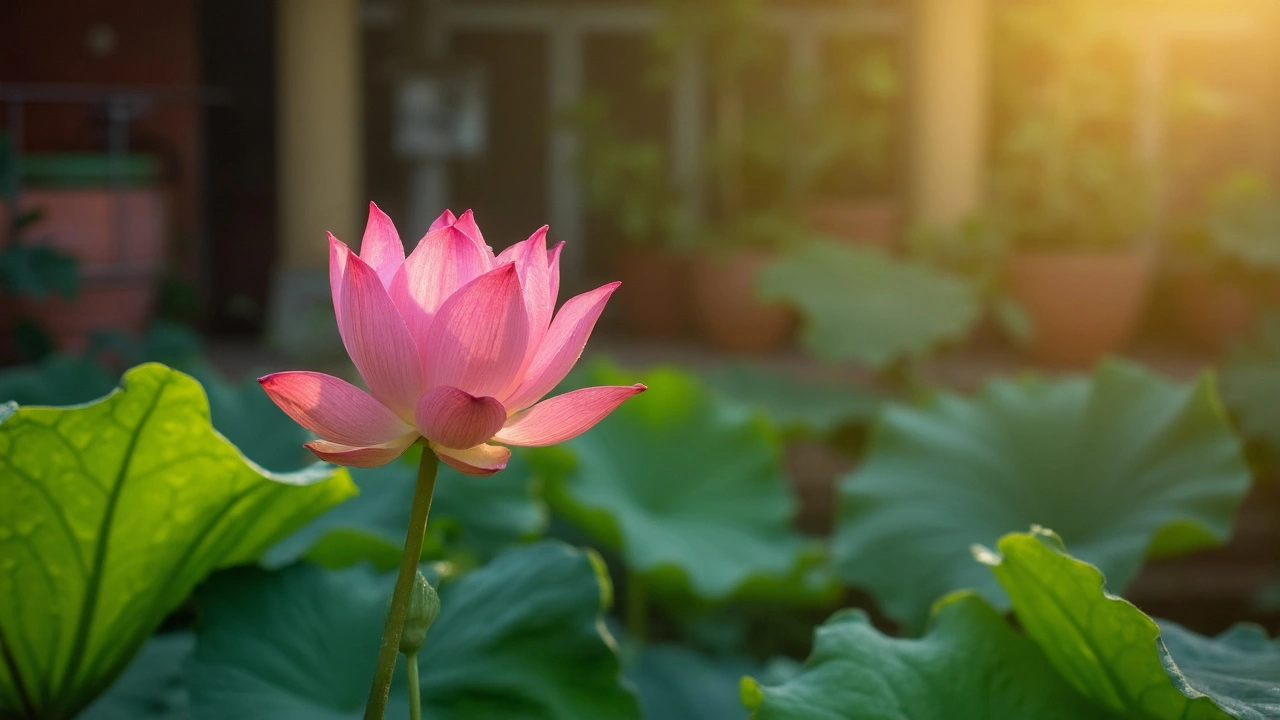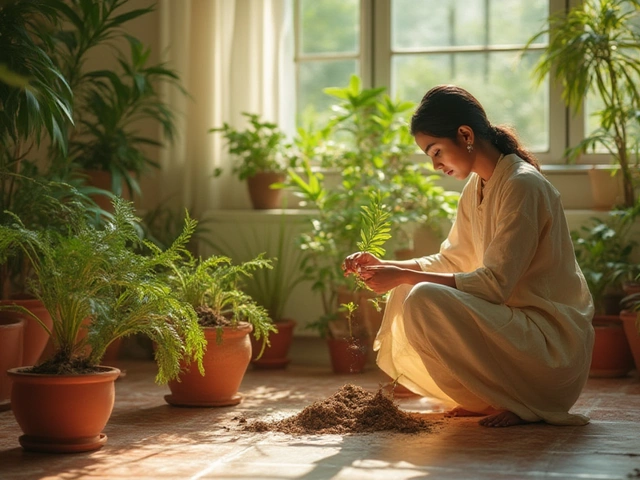If you’ve ever seen a healthy lotus in full bloom, it’s hard not to wonder—how long can it actually last? This isn’t just about a single flower. Lotus plants are more than a pretty face; they’re surprisingly hardy, and their life story is packed with little surprises.
Unlike most everyday flowers, lotus isn’t just a ‘plant-it-and-forget-it’ kind of deal. The actual flower might bloom for three to five days, but the whole plant? If you care for it right, a single lotus rhizome can crank out new flowers year after year. Some gardeners in India have kept the same lotus patch going for decades, all by keeping an eye on water, sunlight, and the right kind of mud.
Not sure where to start? Keeping your lotus alive isn’t about complicated tricks or fancy chemicals. It’s about smart timing—giving them a winter rest, watching for root rot, and not letting the pot dry out. With a little attention, your lotus can be around a lot longer than you’d expect.
- How Lotus Grows and Blooms
- Seasonal Lifespan: Flower, Leaf, and Rhizome
- What Makes a Lotus Last Longer
- Common Mistakes That Kill Lotus Early
- Reviving an Old Lotus Plant
- Pro Tips for Growing Lotus in Indian Gardens
How Lotus Grows and Blooms
The lotus is pretty unique compared to regular garden flowers. It starts from a thick, starchy rhizome—think of it as a fat underground stem—that sits right in the mud at the bottom of a pond or a big water tub. When the weather heats up, the rhizome wakes up from dormancy and sends out new shoots. These shoots become tall, straw-like stems, which then push out leaves and, eventually, flower buds.
Lotus leaves are easy to spot: they’re round, waxy, and float like big plates on water. Actually, they do more than float. Some stand tall above the surface, while others lie flat, soaking up sunlight and keeping rainwater away from the delicate center.
The real magic happens when those thick stems send up a flower bud. That bud will slowly rise and, within a few days, open into a full lotus flower. In most Indian climates, you’ll see blooms from late spring to mid-monsoon—basically, whenever it’s hot and there’s enough sun. A single flower usually lasts about 3-5 days, and after that, the petals fall away, leaving behind a familiar seed pod.
This plant’s got a rhythm: new leaves, new flowers, and then back to rest in winter. By late October or November, as temperatures drop, the lotus slows down, leaves and stems turn brown, and the plant essentially “hibernates” until things warm up again.
If you give them good sun (at least 6 hours a day), shallow but roomy water pots, and a regular shot of organic fertilizer, lotus can keep growing for years. Some plants in India have been passed down for generations, growing back each year from that same tough rhizome. So when thinking about the lotus lifespan, you’re looking at a cycle—grow, bloom, rest, repeat—that can go on as long as you let it.
Seasonal Lifespan: Flower, Leaf, and Rhizome
Lotus isn’t just about the flower on the surface; each part of the plant—flower, leaf, and rhizome—has its own lifespan. Understanding this can help you keep your lotus lifespan going strong each season.
Let’s break it down. The actual lotus flower, the one that grabs the spotlight, lasts about three to five days. After blooming, petals drop, but don’t pull out the stem by hand—let it dry and fall back naturally so you don’t damage the plant. New flowers will keep coming up during the warm months if your plant is healthy.
Leaves last a bit longer. You’ll see new leaves pushing out as long as the weather stays warm—usually from late spring till early autumn across most of India. Old leaves turn yellow, then brown, and finally die off as winter creeps in. That’s totally normal. Don’t yank off the dying ones; just cut them close to the base once they’re crispy dry.
The real secret to a long-lived lotus is the rhizome—the root-like part living below the water. Think of it like the plant’s memory stick, storing energy all through the year. Even if the leaves and flowers disappear during winter, the rhizome is still alive under the mud, ready to make a comeback when things warm up. A healthy rhizome can survive for years with the right care, which is why lotus can keep going season after season.
| Part | Active/Lifespan |
|---|---|
| Flower | 3 – 5 days (per bloom) |
| Leaf | 2 – 3 months (per leaf) |
| Rhizome | 5+ years (with care) |
If you’re growing lotus in a pond or a large tub, expect to see the whole show start in late March or April, peak with non-stop blooms all summer, and wind down by October. When the cold sets in, the plant looks dead on top—but the rhizome is just resting.
Quick tip: Avoid poking or disturbing the mud during winter. That’s when the rhizome is most fragile, and any harsh moves can kill next year’s shoots.
What Makes a Lotus Last Longer
If you want your lotus to stick around for years, you’ve got to know what keeps it happy. Lotus isn’t too demanding, but there are a few things you can’t ignore. Let’s break down what really matters when you want that same plant blooming every summer.
First, sunlight is non-negotiable. Your lotus needs at least 6 hours of direct sunlight a day to keep powering through the growing season. Lotus grown in shade just won’t last as long or flower as much. And you have to let the plant get its rest—winter dormancy is a must, so don’t try to force it early. Plants left outside in Indian winters bounce back better than those indoors.
Good water matters just as much. You don’t want your water stagnating or getting full of algae. If you’re container-growing, change out a little water every week, but don’t go overboard—lotus loves stable conditions. In ponds, keep the water clean and at least 20-30 cm deep for strong roots. Shallow or dirty water is a quick way to rot the rhizomes.
Speaking of soil, lotus hates rich garden dirt. Go for sticky clay or special aquatic soil. Avoid chemical fertilizers—the trick is a slow-release fertilizer once a month during growth. Overdo it, and you’ll see leaf burn instead of blooms.
- Lotus lifespan jumps when you keep plants stress-free, especially at the roots.
- Pot size matters—use a big container (minimum 40cm wide) to let rhizomes grow and split every couple of years.
- Whenever flowers and leaves fade, trim them way back. This stops rot from spreading and lets the rhizome focus on fresh growth.
Here’s a quick reference with typical lifespan numbers:
| Lotus Part | Lifespan |
|---|---|
| Single Flower | 3-5 days |
| Leaf | Up to 2 months |
| Rhizome (plant base) | 5-20+ years, if kept healthy |
Lots of old temple ponds in South India have lotus growing in the same spot for decades, even centuries, mostly because the conditions stay stable and people clear away old leaves regularly. To keep yours in good shape, watch for signs of pests—aphids, snails, and spider mites love lotus leaves. Washing them off with water or picking by hand usually works.
Bottom line: Long-lasting lotus comes down to steady care, good sunlight, clean water, and space for those rhizomes to grow. Skip the fancy stuff and stick to these basics, and you’ll see new blooms popping up year after year.

Common Mistakes That Kill Lotus Early
Want your lotus to keep coming back year after year? Watch out for these common blunders. Even experienced gardeners let these things slip. Knowing what to avoid will help you keep your lotus healthy and blooming longer.
- Water Depth Woes: Too much or too little water spells trouble for lotus. If water's deeper than 60 cm, the leaves might not reach the surface. If it's too shallow, things heat up fast and fry the roots.
- Poor Sunlight: Lotus need at least six hours of direct sunlight every day. Skip this and you’ll get weak, sad plants with hardly any blooms.
- Wrong Soil Mix: Forget fancy garden soil or compost. Regular kitchen soil clogs the pond and causes rot. Use heavy topsoil with a bit of clay—skip the organics, as too much can lead to stinky, rotting water.
- Over-fertilizing: Lotus roots are sensitive. Dumping in loads of fertilizer will burn roots and stunt growth. The right time is after leaves appear—once a month during the growing season.
- No Winter Rest: In India, lotus plants need a winter break. Don’t keep them growing non-stop indoors because it just exhausts the plant. Let them go dormant.
- Ignoring Pests and Disease: Aphids and leaf spot show up fast in warm, still water. Waiting too long to act is a classic lotus killer.
- Disturbing the Rhizome: A cut or bruise on the fleshy root means it rots quickly. Handle with real care; even a small injury can wipe out a whole plant.
Here’s a quick snapshot of what stresses a lotus plant and what happens if you mess up:
| Problem | What Happens | How Fast |
|---|---|---|
| Too little sunlight | No flowering, yellow leaves | 1-3 weeks |
| Too much fertilizer | Root burn, slow growth | 7-10 days |
| Damaged rhizome | Rhizome rot, whole plant dies | As quick as 1 week |
| Shallow water | Roots dry out, leaves wilt | 2-5 days in summer |
| Pest infestation | Stunted growth, holes in leaves | Ongoing unless treated |
The trick? Nail the basics. Stable water, strong sunlight, right soil, and careful handling. Skip shortcuts—that’s how you end up replacing your lotus every monsoon.
Reviving an Old Lotus Plant
If your lotus has stopped blooming or the leaves look half-dead, it doesn’t always mean it’s done for good. Lotuses look dramatic when neglected, but surprisingly, they can bounce back if you know what to do. The biggest reason old lotus plants slow down is care mistakes—mostly clogged-up soil, stale water, or crowded pots. Here’s how you can bring your tired lotus back to life.
Lotus lifespan is mostly about the health of its rhizomes (the thick, underground stems). These store energy and are responsible for those fresh green shoots every spring. When they get mushy or smelly, it’s time to act fast.
- Dig up and Clean: Gently pull the rhizome out during late winter or early spring. Use your hands instead of tools—the rhizome bruises easily.
- Rinse and Inspect: Wash off old mud, then check for black, mushy, or rotten sections. Slice off any damaged bits using a sharp, clean knife. Healthy rhizomes should be firm and cream-colored, not soft.
- Sun and Rest: Let the healthy pieces ‘rest’ in bright shade for a few hours to toughen up those cut ends. This helps fight off rot when you replant them.
- Replant in Fresh Mud: Fill your container (or pond shelf) with clean garden soil mixed with compost—avoid chemical fertilizers at this stage. Bury the rhizome just under the surface, angled sideways, so new shoots have room to pop up.
- Change Water Regularly: Bad smells and green slime drive lotuses crazy. Every two weeks, scoop out and replace about a third of the water if you’re growing in a tub or small pond.
- Feed After New Leaves: Only start feeding with mild fertilizer after two sets of new leaves show up. Overfeeding too soon will burn the roots.
Here’s how different factors affect how fast a lotus bounces back:
| Factor | Impact on Recovery |
|---|---|
| Fresh Soil Quality | Fresh, nutrient-rich mud speeds up new growth by 30-40% |
| Water Temperature | Lotus needs at least 20°C—plants recover slower below this |
| Sunlight Exposure | Six hours or more of sun improves greening and flower count |
| Pot Space | Cramped roots cut recovery time in half; more space = healthier plant |
Don’t expect instant results. New shoots might take three to eight weeks, depending on how tough winter was and how much sun you’ve got. The most common mistake? Drowning the rhizome under too much water—always cover with just enough to keep things damp, not soggy. Give your old lotus a second chance and you might just get even more blooms the next year.
Pro Tips for Growing Lotus in Indian Gardens
If you want your lotus to stick around for years, you’ve got to nail the basics. Growing lotus in India isn’t tough, but there are a few tips that set apart a thriving pond from one where nothing survives summer.
- Lotus lifespan starts with sun. Your plant needs at least 6 hours of full sunlight every day. Morning sun is best, especially in hot states. Without this, leaves get weak and flowers barely show up.
- Use wide and shallow containers (at least 40 cm wide and 15-20 cm deep) if you’re growing them in tubs or pots. Too deep and the plant struggles. Traditional Indian ponds work well because they’re naturally shallow at the edges.
- Quality matters: Fill your container with clay-rich garden soil. Skip potting mixes with wood chips or coco peat—lotus hates it. Add a layer of clean sand on top to keep the water from getting muddy.
- Keep the water level right: For new plants, 5-8 cm of water above the soil works. Mature lotus can handle 15-25 cm. Top up every few days, especially during scorching Indian summers.
- Fertilize at the right time: Don’t feed in winter when the plant looks dead. Best time is just as new leaves appear, usually by late February or March in most parts of India. Use slow-release aquatic fertilizer tablets or a pinch of cow dung—they both work great.
- Avoid crowding: If the plant gets root-bound, divide it in early spring. This lets your lotus spread out and keeps rhizomes healthy. Cutting old leaves also cuts down on pests.
Want specifics? Here’s a simple data table based on actual backyard lotus gardens from Hyderabad, Kolkata, and Lucknow. These are average results for garden-grown lotus when basic care is followed:
| City | Sunlight (hrs/day) | Water Depth (cm) | Flowers per Season | Survival Rate After 3 Years |
|---|---|---|---|---|
| Hyderabad | 7 | 20 | 16 | 92% |
| Kolkata | 6.5 | 18 | 19 | 89% |
| Lucknow | 8 | 22 | 21 | 95% |
Also, don’t forget to change out about a third of the water every two weeks in pots, just to keep things fresh. And keep an eye out for aphids—just blast them off with water. That’s it. With these tips, your lotus will keep bouncing back season after season, and you’ll have more flowers than you know what to do with.





